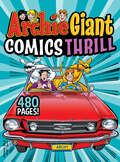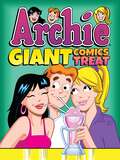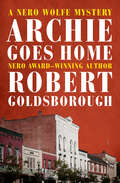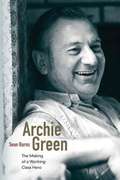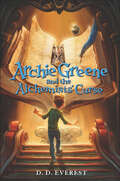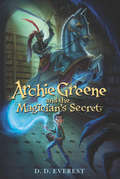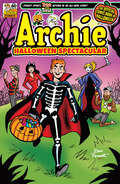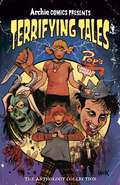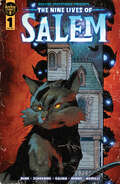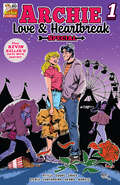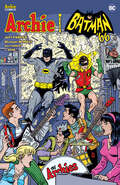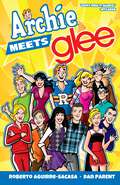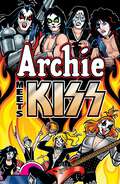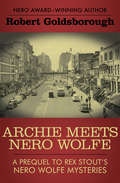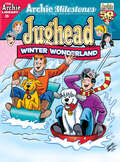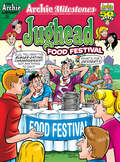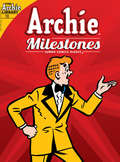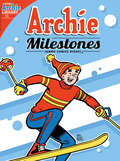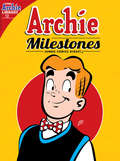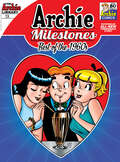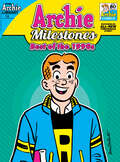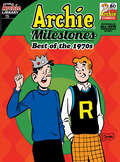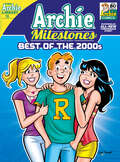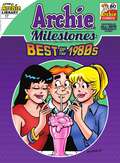- Table View
- List View
Archie Giant Comics Thrill (Archie Giant Comics Digests #18)
by Archie SuperstarsARCHIE GIANT COMICS THRILL offers popular, proven full-color content at the same price and page count as most black-and-white mass-market paperbacks. This is the next volume of our new series of super-value Archie comics collections featuring 480 pages of stories in the same format as our #1 best-selling Archie Digest kids' magazine series and 1000 Page Digest book series. Designed for venues dedicated to offering customers the best value in kids' books today at an affordable price, such as grocery stores, drug stores, and mass merchants, as well as traditional book outlets.This volume collects 480 pages of iconic Archie comic stories, featuring the same mix of wild humor, awkward charm and genuine relatability that has kept Archie and the gang popular with kids and families for 80 years.
Archie Giant Comics Treat (Archie Giant Comics Digests #9)
by Archie SuperstarsARCHIE GIANT COMICS TREAT collects 480 pages of iconic Archie tales in this one amazing volume! Follow America's favorite red-head as he navigates the pressures of the American teenager in the awkward, charming, and hilarious way you've come to know and love.
Archie Goes Home (The Nero Wolfe Mysteries #15)
by Robert GoldsboroughArchie Goodwin leaves Manhattan for the Midwest to find out who put a bullet into a banker. Archie Goodwin&’s aunt Edna is about to lure him away from his work at Nero Wolfe&’s New York brownstone. After a phone call, he heads off to Ohio, where the president of Farmer&’s State Bank and Trust, an elderly widower, has died in an apparent suicide. But Archie&’s aunt has expressed nagging suspicions—which only grow stronger when someone takes a shot at a local reporter who wrote about the case. It wouldn&’t be a small town without some gossip, and Archie soon hears the whispers: romantic intrigues, a possible paternity case, a ruined business. While reconnecting with his aging mother—and fending off his nagging aunt—Archie tries to untangle a web of grudges, scandals, and murder. From Nero Award winner Robert Goldsborough, this is a brand-new novel in the series created by Rex Stout, starring one of the world&’s most beloved detectives and his equally engaging sidekick. Archie Goes Home is the 15th book in the Nero Wolfe Mysteries, but you may enjoy reading the series in any order.
Archie Green: The Making of a Working-Class Hero
by David Roediger Nick Spitzer Sean BurnsArchie Green: The Making of a Working-Class Hero celebrates one of the most revered folklorists and labor historians of the twentieth century. Devoted to understanding the diverse cultural customs of working people, Archie Green (1917-2009) tirelessly documented these traditions and educated the public about the place of workers' culture and music in American life. Doggedly lobbying Congress for support of the American Folklife Preservation Act of 1976, Green helped establish the American Folklife Center at the Library of Congress, a significant collection of images, recordings, and written accounts that preserve the myriad cultural productions of Americans. Capturing the many dimensions of Green's remarkably influential life and work, Sean Burns draws on extensive interviews with Green and his many collaborators to examine the intersections of radicalism, folklore, labor history, and worker culture with Green's work. Burns closely analyzes Green's political genealogy and activist trajectory while illustrating how he worked to open up an independent political space on the American Left that was defined by an unwavering commitment to cultural pluralism.
Archie Greene and the Alchemists' Curse (Archie Greene Ser. #2)
by D. D. EverestArchie Greene and his fellow Flame Keepers return in the action-packed sequel to Archie Greene and the Magician’s Secret. Middle grade readers will love this new installment in a favorite fantasy series. Perfect for fans of Linda Sue Park’s Wing and Claw and J. A. White’s Thickety series.It’s been nearly three hundred years since anyone’s received the Golden Circle firemark, but when the symbol appears on Archie’s palm, it marks the resurgence of the Alchemists’ Club and its dreaded curse.Archie Greene is doomed, and he’s got the firemark to prove it. The last time the Golden Circle appeared, the marked apprentices were never heard from again. The rebirth of the Alchemists’ Club is met with uneasiness, but it’s clear the present is not so different from the past. The charms protecting the magical texts the Flame Keepers have sworn to look after are fading. If the spells are not rewritten, the little magic left in the world may fall into the hands of the dangerous Greaders.But can Archie and his friends rewrite the magic in time or will the Alchemists’ curse strike once more?
Archie Greene and the Magician's Secret (Archie Greene Ser. #1)
by D. D. EverestD. D. Everest's magical middle grade debut, filled with enchanted books and mysterious activity, is sure to captivate readers. Open this book . . . if you dare to face what awaits you inside!On his twelfth birthday, Archie Greene receives a mysterious package containing an ancient book in a language he doesn't recognize. The gift leads him to a family he didn't know he had and a world he never knew existed.With the help of his cousins, Bramble and Thistle, Archie tries to unravel the mystery behind his book, but he begins to realize that his gift is something more powerful than he could have imagined. And the only thing more perilous than its contents is being its owner. The book waited four hundred years for Archie Greene. Now Archie must discover why.
Archie Halloween Spectacular (Archie Halloween Spectacular #1)
by Archie SuperstarsBRAND NEW STORY: “Monster Mash-Up!” Trick and Treat return on Halloween night to harass Archie and Jughead with assorted monsters until Sabrina takes charge. All that plus more scary-fun stories!
Archie Horror Presents: Terrifying Tales (Archie Horror Presents #2)
by Archie SuperstarsArchie Comics continues to terrify with this collection of seven tales featuring final girls, grotesque gourmands, frightening fandom, summer camp slashers and more! TERRIFYING TALES is a feast for any horror-hungry fans, with everything from psychological thrillers to dimension-bending sci-fi. Madam Satan and Jinx are joined by Danni Malloy, Bingo Wilkin, and others in a true terror tour through the depths of Hell and back. Beware as you read horror stories from every corner of the Archie Universe! Featuring a retro, distressed cover by horror comic master Robert Hack. This collection includes the following one-shots: BETTY: THE FINAL GIRL, POP’S CHOCK’LIT SHOPPE OF HORRORS, THE CULT OF THAT WILKIN BOY, JINX: A CURSED LIFE, CAMP PICKENS, STRANGE SCIENCE, AND MADAM SATAN: HELL ON EARTH.
Archie Horror Presents: The Nine Lives of Salem (Archie Horror Presents #1)
by Cullen BunnSalem was once a powerful warlock whose misuse of powers led him to live the rest of his life in servitude, acting as a cat familiar to a family of witches. But even in feline form, he can’t escape the sins of his past. And when some familiar faces return seeking revenge, he might just use up all of his nine lives trying to save himself from their wrath.
Archie Love & Heartbreak Special (Archie (2015-))
by Sina Grace Stephanie Cooke Thomas PitilliAN ALL-NEW ROMANCE ANTHOLOGY PERFECT FOR FANS OF ARCHIE’S MODERN COMIC SERIES! Join Archie and his friends on a date night at the Riverdale carnival! First up, Betty wants to know: If Jughead was interested in dating, what would the perfect date look like? Jughead shares his POV on love while Archie and Veronica’s relationship is on the rocks! Can Kevin Keller help Archie save his romance? Maybe not, since Kevin’s caught up in his own romantic dilemma, and is worried about being in over his head on his own date! Who will end up together? What relationships are on the verge of collapse? Who will find true love?
Archie Meets Batman '66
by Jeff Parker Michael MoreciGotham City meets Riverdale in this crossover graphic novel that brings together some of the most iconic characters in comics and television!Two iconic comic book characters meet up for the FIRST TIME in this historic crossover mini-series! A battle in Gotham City extends its reach into Riverdale--with Mr. Lodge becoming enemy #1 of the dynamic duo! Now it's up to Veronica to recruit some help and place a call... to the Batcave!
Archie Meets Glee (Archie & Friends All-Stars #20)
by Roberto Aguirre-SacasaArchie and his friends, with the help of Dilton Doiley and his "PORTAL-PORTER," are transported to McKinley High School, where they meet the lead characters of Fox's hit TV show GLEE. When Archie, Betty, Veronica, Jughead and the rest of the Riverdale gang meet Rachel, Finn, Artie, Kurt and the whole New Directions Glee Club, that's when all the fun starts. It's an unforgettable crossover for both Gleeks and Archie fans alike!
Archie Meets KISS
by Alex SeguraZOMBIES IN RIVERDALE! The biggest comic book crossover in history, in one essential volume! Two of the most iconic groups in pop culture meet for the first time as the rock-fueled demons of KISS crash-land in Riverdale, home to America&’s favorite teenager, Archie Andrews! When one of Sabrina the Teenage Witch&’s spells goes awry and summons forth a gang of dangerous monsters bent on turning the people of Riverdale into mindless zombies, what can Archie, Jughead, Reggie, Kevin Keller, and Betty & Veronica do to save their town? Enter KISS: The Demon, Starchild, Catman, and Spaceman, four supernatural heroes with their sights set on the frightening invaders and their mysterious weapon, the Dynasty Amulet. Featuring the iconic artwork of superstar Dan Parent and an off-the-wall story by Alex Segura.
Archie Meets Nero Wolfe: A Prequel to Rex Stout's Nero Wolfe Mysteries (The Nero Wolfe Mysteries #8)
by Robert GoldsboroughAn &“excellent&” novel that goes back to 1920s New York to reveal how the famed detective first met his incomparable sidekick (Publishers Weekly, starred review). In 1930, young Archie Goodwin comes to New York City hoping for a bit of excitement. In his third week working as a night watchman, he stops two burglars in their tracks—with a pair of hot lead slugs. Dismissed from his job for being &“trigger-happy,&” he parlays his newfound notoriety into a job as a detective&’s assistant, helping honest sleuth Del Bascom solve cases like the Morningside Piano Heist, the Rive Gauche Art Gallery Swindle, and the Sumner-Hayes Burglary. But it&’s the kidnapping of Tommie Williamson, the son of a New York hotel magnate, that introduces Goodwin to the man who will change his life. Goodwin knows there&’s only one detective who can help find Tommie: Nero Wolfe, the stout genius of West Thirty-Fifth Street. Together, they&’ll form one of the most unlikely crime fighting duos in history—but first Goodwin must locate Tommie and prove that he deserves a place by Wolfe&’s side. In this witty story about the origin of a legendary partnership, Robert Goldsborough gloriously evokes the spirit of Nero Wolfe&’s creator, bestselling author Rex Stout, and breathes new life into his beloved characters.
Archie Meets Nero Wolfe: A Prequel to Rex Stout's Nero Wolfe Mysteries (The Nero Wolfe Mysteries #8)
by Robert GoldsboroughAn &“excellent&” novel that goes back to 1920s New York to reveal how the famed detective first met his incomparable sidekick (Publishers Weekly, starred review). In 1930, young Archie Goodwin comes to New York City hoping for a bit of excitement. In his third week working as a night watchman, he stops two burglars in their tracks—with a pair of hot lead slugs. Dismissed from his job for being &“trigger-happy,&” he parlays his newfound notoriety into a job as a detective&’s assistant, helping honest sleuth Del Bascom solve cases like the Morningside Piano Heist, the Rive Gauche Art Gallery Swindle, and the Sumner-Hayes Burglary. But it&’s the kidnapping of Tommie Williamson, the son of a New York hotel magnate, that introduces Goodwin to the man who will change his life. Goodwin knows there&’s only one detective who can help find Tommie: Nero Wolfe, the stout genius of West Thirty-Fifth Street. Together, they&’ll form one of the most unlikely crime fighting duos in history—but first Goodwin must locate Tommie and prove that he deserves a place by Wolfe&’s side. In this witty story about the origin of a legendary partnership, Robert Goldsborough gloriously evokes the spirit of Nero Wolfe&’s creator, bestselling author Rex Stout, and breathes new life into his beloved characters.
Archie Milestone Digest #26: Jughead Winter Wonderland (Archie Milestones Digest #26)
by Archie SuperstarsSip some cocoa, throw some snowballs, and creates some special snowy memories with Jughead, Hot Dog, and all his friends in Riverdale!
Archie Milestone Digest #27: Jughead New Years Bash (Archie Milestones Digest #27)
by Archie SuperstarsRing in the New Year with Jughead Jones and all his friends in Riverdale with these stories all about celebrations, resolutions, and good times!
Archie Milestones Digest #10 (Archie Milestones Digest #10)
by Archie SuperstarsThis installment of Archie’s Milestones Jumbo Comics Digest celebrates the world of Archie—all of them, that is! This issue will showcase some of the wildest, most mind-blowing stories, including a few that take a look into the future and stories where Archie meets Archie—yes, you read that right!
Archie Milestones Digest #11 (Archie Milestones Digest #11)
by Archie SuperstarsGet into the festive spirit with this collection of Archie’s most memorable holiday tales, family celebrations and all-around feel good stories!
Archie Milestones Digest #12 (Archie Milestones Digest #12)
by Archie SuperstarsThis final issue of the Archie Milestones Jumbo Comics Digest is a cause for celebration—so much so it’s filled to the brim with stories about celebration and parties! But it’s not only fun and games, it also includes some important, teachable moments courtesy of Archie and the Gang as well as some far away travel—like a galaxy far, far away!
Archie Milestones Digest #13: The 1960s (Archie Milestones Digest)
by Archie SuperstarsTHE ARCHIE MILESTONES DIGEST SERIES RETURNS! We’re continuing celebrating Archie’s long-lasting legacy of 80+ years of publishing with a special retroactive look at some of the most important eras in Archie’s history! First up: the 1960s, the Silver Age of comics and the decade that brought us the birth of The Archies! Plus, stories from every decade of Archie. There’s something for fans of all ages!
Archie Milestones Digest #14: Best of the 1990s (Archie Milestones Digest #14)
by Archie SuperstarsBRAND NEW STORY: “I Won’t Be There for You” Archie and the girls are excited to see a live taping of their favorite sitcom “Buddies.” But when the cameras are off, the cast starts fighting like a bunch of entitled Hollywood brats! It’s up to Archie, Betty & Veronica to reignite their friendship!
Archie Milestones Digest #15: Best of the 1970s (Archie Milestones Digest #15)
by Archie SuperstarsFEATURING A BRAND NEW “THROWBACK” STORY: “Watch and Roll!“ When Archie is floored by Reggie’s superior moves at the roller disco, Jughead offers to teach him how to boogie down in the rink… but does Jughead himself actually know how to skate? Chaos is sure to ensue in this groovy throwback story set in the 1970s!
Archie Milestones Digest #16: The Best of the 2000s (Archie Milestones Digest #16)
by Archie SuperstarsWe travel back to the start of the Millennium with this digest spotlighting the best of the 2000s, beginning with a BRAND NEW STORY! In “Movie Melee,” Archie and the gang are spending the summer at his family’s rental lake house. They’re having a grand old time having fun in the sun, camping, and watching movies in the cabin at night, where Archie discovers the newest technology: “NETFILMS” a service where DVDs are delivered to him several times a week! But when Archie keeps receiving mail from them once the summer ends, he’s starting to wonder if something’s glitchy about this new service!
Archie Milestones Digest #17: Best of the 1980s (Archie Milestones Digest #17)
by Archie SuperstarsBRAND NEW STORY! In “Back to the Past,” After being bombarded by texts and group chats about parties and events, Betty and Veronica talk about how things in the “olden days” must have been so much simpler. That gives them an idea: throw a retro ’80s style party! But can they have fun without smartphones? Lace up your roller skates and find out!
